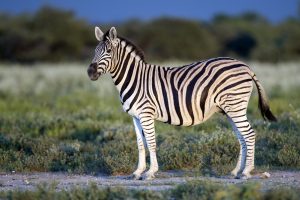Plains Zebra
 Scientific Name : Equus quagga
Scientific Name : Equus quagga- IUCN Status : Near Threatened
- It is the most common and geographically widespread species of zebra.
- Its range is fragmented, but spans much of southern and eastern Africa south of the Sahara.
- Six or seven subspecies have been recognised, including the extinct quagga which was thought to be a separate species.
- The plains zebra is intermediate in size between the larger Grévy’s zebra and the smaller mountain zebra and tends to have broader stripes than both.
- Burchell’s zebra was thought to have been hunted to extinction.
- The plains zebra stands at a height of 127–140 cm (4.17–4.59 ft) with a head-body length of 217–246 cm (7.12–8.07 ft) and a tail length of 47–56.5 cm (1.54–1.85 ft).
- Males weigh 220–322 kg (485–710 lb) while females weigh 175–250 kg (386–551 lb).
- The species is intermediate in size between the larger Grévy’s zebra and the smaller mountain zebra.
- Plains zebras primarily feed on grass; preferred species being Themeda triandra, Cynodon dactylon, Eragrostis superba and Cenchrus ciliaris. Zebra sometimes browse or dig for corms and rhizomes during the dry season. They appear to partial to eating scorched Colophospermum mopane and Pterocarpus rotundifolius, consuming both the leaves and twigs.
